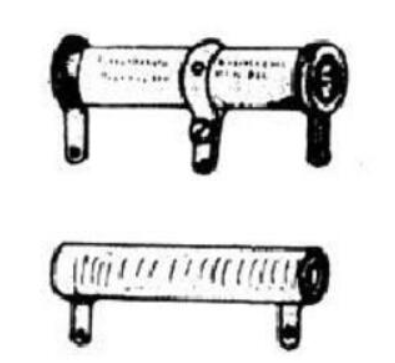Introduction to wire wound resistors
It is made of special alloys such as constantan, manganese copper and other special alloys made of filaments wound on the insulating tube. There is a protective layer on the outside. The protective layer has two kinds of general enamel and moisture-proof enamel. There are two types of wire wound resistors: fixed and adjustable, as shown in Figure 4-8. The advantages of this kind of resistance are: accurate resistance, good electrical performance, reliable and stable operation, low temperature coefficient, good heat resistance, and high power. The disadvantage is that the resistance is not large and the cost is high. Wirewound resistors are suitable for circuits that require large power, and some can be used where precision resistance is required. But because of the inductance, it is not suitable for high-frequency circuits.

Advantages of wire wound resistors
The resistance accuracy is extremely high, the noise is small, stable and reliable when working, the temperature coefficient is small, it can withstand high temperatures, and it can still work normally at an ambient temperature of 170°C.
Disadvantages of wire wound resistors
It is large in size and low in resistance, mostly below 100KΩ.
Winding resistance classification
Wirewound resistors are pided into fixed resistors and adjustable resistors. The winding of the adjustable part of the adjustable resistor is bare, which is not conducive to the stability of the resistance. It is called the structure of some wirewound resistors.
Winding resistance specifications
The specification parameters of winding resistance mainly include accuracy error, power and temperature. The accuracy error of winding resistance is: ±5%, ±2%, ±1%; the power range of winding resistance is 1/4W~10W; winding The rated temperature range of the resistor is 70°C, and the operating temperature range is: -55°C to 155°C. There is also a basic specification parameter for wire-wound resistors, which is the resistance value. The nominal resistance value of the wire-wound resistor is 10Ω.
The role of wire wound resistors
Wire-wound resistors are composed of resistance wires wound on an insulating framework, and are generally made of a medium with a certain resistivity, such as nickel-chromium, manganese copper and other alloys. Wire-wound resistors are mainly used in low-frequency AC circuits to reduce voltage, shunt, load, feedback, energy transfer, matching, etc., or act as absorbers and voltage piders in power circuits, and can also be used as oscillations Attenuation adjustment in loops and transformers and shunts in pulse forming circuits. In addition, it can also be used for discharge and spark suppression of filter stage capacitors in rectifiers. At the same time, it can be widely used in household appliances, medical equipment, automobile industry, railway, aviation, military equipment and other fields.
High-power wire wound resistor structure and manufacturing process
Wirewound resistors have a simple process. The domestic technology is quite mature and has a wide range of applications. I believe many people have a certain understanding of it, but do you know the manufacturing process of wirewound resistors in terms of materials? What materials are needed to make a wire wound resistor?
The first is the insulating matrix. The aluminum oxide ceramic tube is generally used as the insulator for wire wound resistors. The high-power wire wound resistors usually use hollow insulating rods as the resistance matrix, while the low-power wire wound resistors usually use solid ceramic rods. The quality of the resistance matrix is different. It will have a very large impact on the heat dissipation and electrical performance of the resistor. The high-power wire-wound resistors produced by Times Jiaying use high-frequency ceramic tubes as the resistance matrix, which has good heat dissipation and insulation.
The second is the resistance wire. The difference in resistance wire material directly determines the temperature coefficient and resistance value of the resistance, and also affects the instantaneous overload capacity of the resistance and the long-term stability of the resistance value. Nickel-chromium alloys are widely used in China, but the quality and craftsmanship of different resistance wire suppliers vary greatly. The important thing is that the composition of the trace elements in the alloy is also different. The high-quality resistance wire has stable performance during the high-temperature sintering process. Times Jiaying RX20 high-power wire wound resistors use Constantan IV as the resistance wire, which has good conductivity and stability.
Finally, there are packaging materials. The packaging materials are more persified, including insulating paint, silicone resin glaze paint, plastic packaging, ceramics, aluminum shells, and so on. Generally speaking, insulating varnish is the cheapest packaging material, and the process is simple. You only need to coat the insulating varnish on the substrate around the resistance wire, and then dry it at low temperature. But the insulation performance is average, and it does not help the heat dissipation of the resistor. For this reason, Times Jiaying RX20 high-power wire wound resistors use nano-silicone coating from Taiwan, which is non-toxic, odorless, good insulation performance, heat-resistant and high-temperature resistant. , Can be used in occasions with high temperature and high reliability requirements.